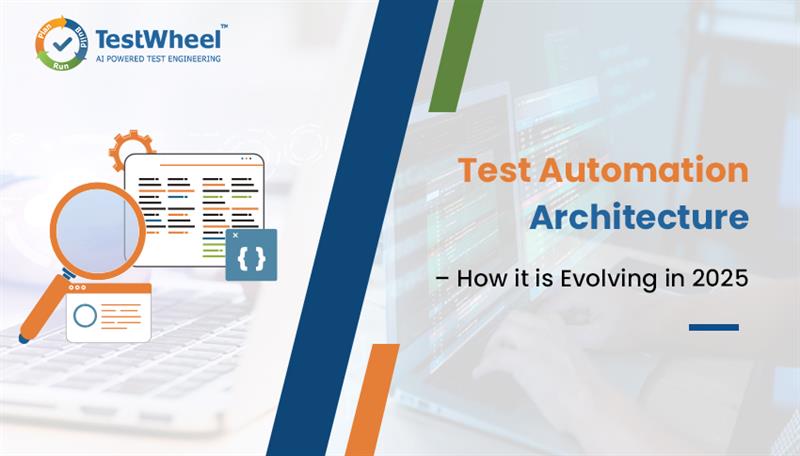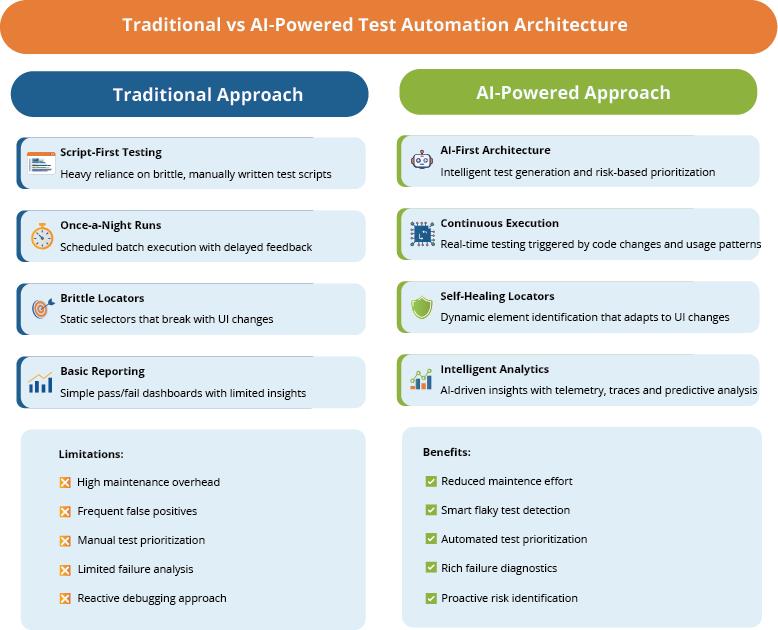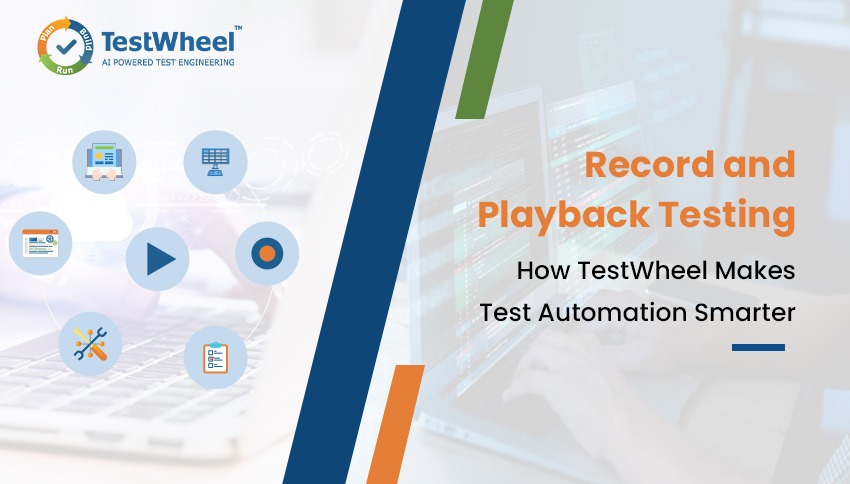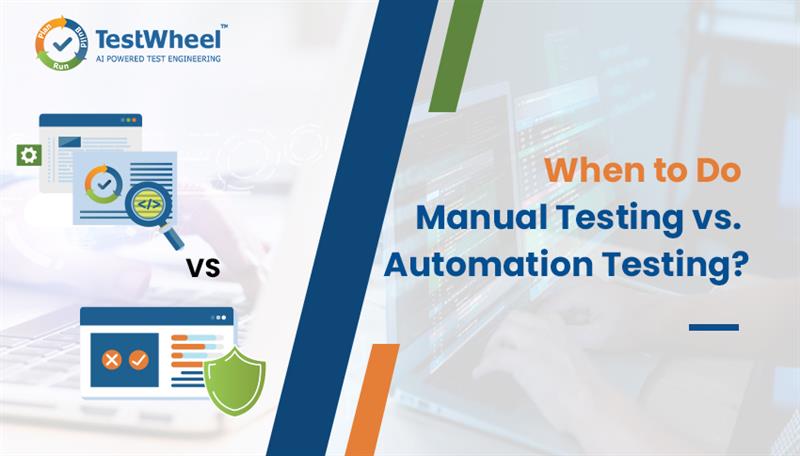- September 17, 2025

Anyone in a QA or dev team who has tried to scale automation beyond double-digit UI scripts knows: tools aren’t enough, architecture is key.
The right test automation architecture is the foundation for any kind of software quality control. It decides how tests are designed, where they are stored, how they should be executed, and how insights should be delivered to decision-makers.
This practical, human-first guide will help development and testing teams adapt their test infrastructure and protocols to future innovations. It will outline the necessity of AI test automation tools, low-code test automation, no-code test automation, and a tool like TestWheel to help future-proof QA ecosystems.
Table of Contents
Test Automation Architecture: A Quick Review
Test automation architecture functions as the operating model for automating software testing. It comprises test layers (unit, API, UI), design patterns (page objects, API clients), the execution backbone (local/cloud runners, containers), and governance (data, environments, reporting, flakiness control).
An efficient test architecture makes it easy to create and execute real tests. It also delivers the right insights for issue resolution. An exceptionally configured stack does more:
- Decouples test logic from app details.
- Isolates flaky dependencies.
- Prioritizes API and integration checks over end-to-end UI.
- Plugs into CI/CD funnels.
Core Building Blocks of Test Automation Architectures
| Layer | What it covers | Why it matters | Notes |
|---|---|---|---|
| Unit tests | Fast checks inside code | Catch issues closest to source; run in milliseconds | Highest volume; run on every commit |
| API tests | Validate data exchanges and services | More stable than UI; isolates backend logic | Contract, happy/sad paths, performance smoke |
| UI tests | End-to-end user journeys | Validate real user flows across layers | Keep to critical paths; minimize flakiness |
How AI is Changing Test Automation Architectures
In the last few years, AI has introduced foundational shifts in software testing operations. Smarter locators and flashy dashboards are no longer enough. AI is changing how tests are built, executed, and evaluated.
Big UI suites, brittle scripts, and once-a-night runs are no longer enough. Test automation architectures need to modernize with low-code and AI-first sensibilities. Here’s what’s changing, why it matters, and how no-code test automation helps teams keep pace.
What’s Changing?
- Older automation stacks are optimized for script-first testing. Modern stacks are focusing on high-quality signals indicating which risks are real, which failures are flaky, and what should run next.
- AI agents are moving towards analyzing code diffs, usage analytics, flaky patterns, and historical failures to prioritize what tests should run in a sprint. LLMs, with adequate training, can decide the right subset of tests to validate only the latest UI and API changes.
- Tests are becoming more stable with self-healing locators, dynamic waits, and content-aware assertions. This translates to less work for testers and fewer instances of flakiness due to minor DOM shifts.
- AI test automation tools capture telemetry (traces, logs, screenshots, timings).

Why Testing Teams Need to Keep Pace with the Change
AI is poised to become an absolute fixture in QA ecosystems, due to the many tangible benefits it brings to the table:
- Improved execution speed, along with risk-based execution as well as adaptive tests to keep build times low. Faster tests with no compromise in quality.
- Lower manual maintenance, fewer flaky tests, and quicker reviews, thanks to self-healing capabilities.
- Continuous training, as models learn from each test run. The earlier a team shifts to modern test automation architecture, the more stability gains they acquire.
- Low-code and no-code capabilities allow non-technical domain experts to contribute directly to tests. Engineers can only focus on complex scenarios and integrations.
- Consistent tracking of data lineage, approvals, and coverage trends.
Needless to say, not having these features in any QA workflow in 2025 will put the team at a significant competitive disadvantage. AI-heavy, low-code pipelines are simply the next step in the perpetual march of innovation.
What “Low-code” Really Means (and how it’s Different from No-code)
Let’s put it this way:
No-code gets you started. Low-code helps you scale.
| Type | Description | Key Features |
|---|---|---|
| No-code Test Automation | Purely visual authoring. |
|
| Low-code Test Automation | Visual authoring plus light scripting/expressions. |
|
Transitioning your Test Automation Architecture: Best Practices & Prerequisites
Upgrading your test automation architecture to low-code and no-code test automation requires a coordinated shift in mindsets, people, workflows, and toolsets. Specifics will vary by team, but this checklist should help make the initial move with minimal effort.
Prerequisites
- Catalog manual and automated tests. Tag each test as Unit / API / UI and mark urgency scores.
- Pick the top 10 APIs and 5 end-to-end journeys.
- Create manual steps that AI engines (like the ones offered by TestWheel) can convert to executable automated test cases.
- Define stable test accounts and IDs.
- Set up ephemeral test environments seeded with the right data.
- Define naming conventions, code review rules, and traceable test IDs.
- Set up clear rules for test suites, environments, and triage duty.
- Run quick training on API testing fundamentals and test design patterns. This is for the people piloting the first few tests on a new platform.
- Quick start on TestWheel’s record and playback tool (for no-code test automation) and parameterization (low-code test automation).
Best Practices
- Use TestWheel’s API testing to validate contracts, happy/sad paths, and schema early—this stabilizes the foundation for UI checks.
- Use AI to convert manual steps into runnable flows and suggest updates when selectors change.
- The AI engine is not another senior tester. Think of it as a junior engineer’s assistant. Use it to run review diffs, enforce naming, and ask for approvals.
- Automate only the business-critical end-to-end journeys, at least to start with.
- Standardize locators and data factories. Don’t build any “one-off” steps.
How TestWheel can Help Modernize Test Automation Architectures for QA teams
Instead of listing out features, let’s talk about how TestWheel can accelerate and refine software testing with AI in test automation, low-code test automation, no-code test automation, unified API testing, mobile, web, and performance. It helps achieve broader team participation in automating software testing without compromising engineering rigor.
- Capture business-critical flows with the recorder. Real interactions can be recorded and converted to reusable, CI-ready steps.
- Chat with the AI Testing Agent in plain language to build tests. Just provide a URL path and set of conversational instructions.
- Upload existing Selenium scripts to convert to manual Automation.
- Reuse the same test cases across environments, browsers and Agile development stages: cross browser testing, functional testing, performance testing, and compatibility testing.
- Get built-in QA testing dashboards, and features to centralize software testing strategy management. Real-time reporting and analytics included.
- Run web, mobile, API tests. Load everything from one place to simplify scheduling, artifacts, and reporting.
- Integrate suites into CI/CD via Azure DevOps and Jenkins plugins.
- Customize & automate API call sequences to match software workflows. This helps prevent unexpected errors.
- Validate API responses as expected values with the built-in assertion validation feature.
TestWheel was originally built to meet the strict security and compliance standards of the U.S. Department of Defense, with native support for Controlled Unclassified Information (CUI) and mission-critical software development. It has passed rigorous vulnerability testing and is Iron Bank-listed, placing it among the DoD’s trusted, hardened software solutions.
The platform meets the high cybersecurity requirements of regulated industries, including banking, finance, insurance, and healthcare. It offers data masking, encryption, and full test lifecycle protection to deliver a secure, enterprise-grade foundation for no-code test automation.



